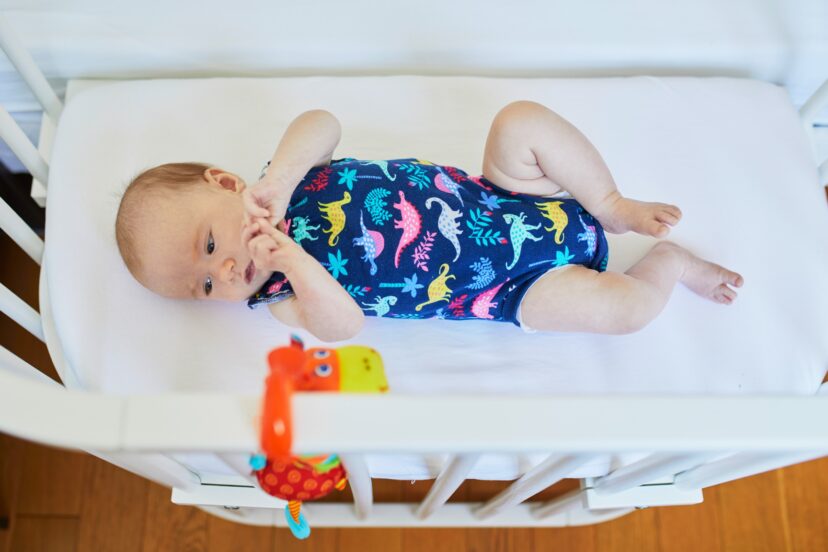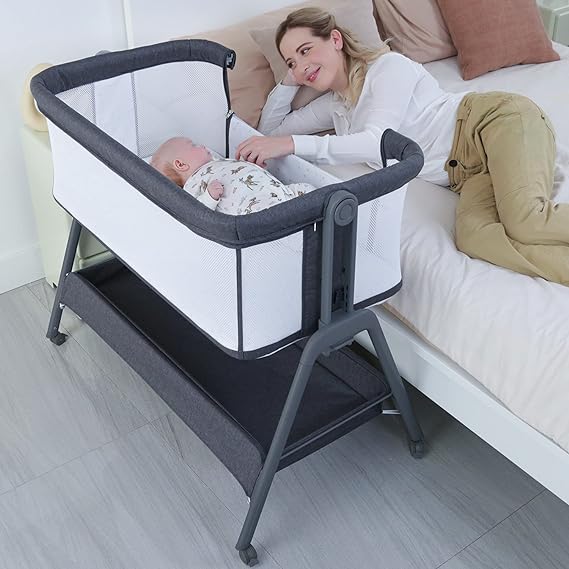How To Get Baby To Sleep In Bassinet – 10 Top Tips
Getting your baby to sleep peacefully in their bassinet can feel like a challenge, especially during those early weeks and months. While every baby is different, many parents struggle with the transition from cuddling in their arms to independent sleep in the bassinet. If you’ve been wondering how to make this process smoother for both you and your little one, you’re not alone! In this post, we’ll explore 10 tried-and-tested tips to answer the question of how to get baby to sleep in bassinet. Whether you’re a new parent or simply looking for strategies to make bedtime easier, these tips are here to help.
In This Article
Why Safe Sleep for Babies is Critical
As a parent, one of our primary concerns is ensuring the safety and well-being of our newborn. A significant part of this is understanding and implementing safe sleep practices, which are crucial for the health and development of our baby. The concept of safe sleep revolves around creating an environment that minimizes risks associated with infant sleep, particularly during the first year of life.
Prevention of Sudden Infant Death Syndrome (SIDS): SIDS, also known as crib death, is the sudden, unexplained death of an infant younger than one year old. While the exact cause of SIDS is unknown, safe sleep practices have been shown to significantly reduce the risk. This includes using a bassinet or crib with a firm mattress, keeping the sleep area free of pillows, toys, and loose bedding, and placing the baby on their back to sleep.
Avoidance of Accidental Suffocation: In an adult bed, there’s a higher risk of accidental suffocation due to soft bedding, pillows, or even a parent inadvertently rolling over onto the baby. A bassinet provides a safer alternative with its firm mattress and enclosed space, designed specifically to meet an infant’s sleep needs.
Promotes Better Sleep Habits: Introducing a bassinet as the primary sleep environment helps in establishing healthy sleep routines for the baby. This environment is free from the disturbances that might occur in an adult bed, like differing sleep schedules and movements.
The Importance of a Bassinet for Baby Sleep
Bassinets serve as a safe and snug spot for your baby to sleep during their first few months. They’re designed to be compact and cozy, mimicking the confining environment of the womb that new-borns find comforting.
Plus, a bassinet’s compact size allows you to keep the baby close for easy night time feeding and comforting, without the risks associated with bed-sharing.
Teaching your baby to sleep in a bassinet has numerous benefits. First, it establishes a healthy and independent sleeping pattern early on, setting the stage for smooth crib transition later. Second, it ensures your baby’s safety by reducing risks like suffocation or overheating, associated with bed-sharing. Lastly, it grants you some much-needed rest and peace of mind, knowing your baby is sleeping safely nearby.
Why Won’t My Baby Sleep In Their Bassinet – Some Common Concerns
Discomfort in the Bassinet
Mattress Issues: If the mattress is either too hard or too soft, it might not provide the comfort the baby needs. A firm, flat mattress is recommended for safety and comfort.
Sensory Preferences: Babies have individual sensory preferences. Some might prefer more cushioning, while others might be sensitive to the bassinet’s texture or material.
Separation Anxiety
Need for Proximity: Especially in the early months, babies often seek the closeness and warmth they associate with their parents. Sleeping alone in a bassinet can trigger anxiety because they feel separated from their primary source of comfort and security.
Developmental Milestones: As babies grow, they become more aware of their surroundings. Around 6-8 months, separation anxiety can peak as they realize when their parent is not around, which might affect their willingness to sleep alone.
Overstimulation Before Bedtime
Busy Daytime Activities: An overstimulated baby might find it hard to wind down. Too much play, interaction, or exposure to screens before bedtime can make it difficult for them to settle into sleep.
Lack of a Calming Routine: The absence of a consistent, calming pre-sleep routine can leave a baby feeling restless. This inconsistency can make the transition to sleep more challenging.
Physical Discomfort
Hunger or Digestive Issues: A baby might resist the bassinet because of physical discomfort like hunger or gas. Ensuring the baby is well-fed and burped before bedtime can help.
Teething or Illness: Discomfort due to teething or illness can also disrupt a baby’s sleep patterns, making the bassinet an unappealing place to rest.
Parental Response
Inconsistent Responses from Parents: If parents quickly move the baby out of the bassinet at the slightest sign of distress, the baby might learn to associate the bassinet with being alone.
How To Get Baby To Sleep In Bassinet – Step-by-Step Guide
Achieving a successful transition to bassinet sleeping doesn’t happen overnight. It requires a structured approach. Here are some of the main things that i found helpful when our boys were making the transition.
Safe and Comfortable Bassinet Setup
Safety Standards: Ensure the bassinet meets current safety standards. It should be stable with no sharp edges or small parts that could pose a risk.
Firm Mattress and Fitted Sheet: Use a firm mattress that fits the bassinet snugly without gaps. The sheet should be tight-fitting and specifically designed for the bassinet to avoid any loose fabric that could pose a hazard.
Minimalist Approach: The bassinet should be free of toys, loose bedding, pillows, and bumpers to prevent any risk of suffocation or entanglement.
Importance of a Calm, Sleep-Friendly Environment
Creating a serene environment promotes better sleep. For your baby, this means a cool, dark, and quiet room.
If your baby wont sleep in a bassinet, then creating an optimal sleep environment involving a blend of safety, comfort, and soothing elements can significantly help in a baby’s acceptance of the bassinet.
Reducing Stimulation: A calm, quiet atmosphere helps signal to the baby that it’s time for rest. Dimming lights and reducing noise levels in the house as bedtime approaches can be beneficial.
Soothing Sounds: While a quiet environment is essential, incorporating gentle, soothing sounds like white noise or soft lullabies can help mask disruptive noises and create a calming ambiance.
Establish a Bedtime Routine
Consistency is Key: A predictable bedtime routine helps signal to your baby that it’s time to wind down. This could include a bath, a gentle massage, a quiet story, or soft lullabies.
Timing Matters: Start the routine at the same time each night to help regulate your baby’s internal clock.
Relaxing Activities: Choose activities that are calming and avoid stimulation right before bed, such as active play or screen time.
The Right Room Temperature
KELVIN is a dynamic color-changing room thermometer that transforms your child's environment into a visual guide. Red for too hot, Amber for just right, and Blue for too cold.
Optimal Temperature for Sleep: Babies sleep best in a room maintained at a temperature comfortable for a lightly clothed adult, typically between 68-72°F (20-22°C).Consider getting a thermometer to help reach the ideal temperature.
Avoiding Overheating: Overheating is a risk factor for SIDS. The baby’s clothing and the room’s temperature should be balanced to ensure the baby is comfortable but not too warm.
Light and Sound Considerations
Soft, Dim Lighting: Bright lights can be stimulating and disrupt the baby’s natural sleep cues. Using a dim night light or soft ambient lighting can be more conducive to sleep.
Consistent Sound Environment: A consistent sound environment can be comforting for a baby. If a family lives in a particularly noisy area, using a consistent sound like white noise can help.
Familiarity and Comfort
Introducing Personal Scent: Sometimes placing a worn but clean piece of the parent’s clothing nearby can provide comfort due to the familiar scent.
Consider a Transitional Object: For older babies, a transitional object like a small baby-safe soft toy can provide comfort in the bassinet, though this should be done in line with safe sleep guidelines.
Introducing the Bassinet to Your Baby
Start with Daytime Naps: Begin by using the bassinet for daytime naps. This can help your baby get used to the new sleep environment.
Incremental Steps: If your baby is resistant, try putting them in the bassinet once they are already asleep, then progressively when they are drowsy but awake.
Stay Close By: Initially, staying close to the bassinet during sleep times can reassure your baby and help them feel more secure.
Dealing with Separation Anxiety
If your baby seems anxious when you leave them alone to sleep in the bassinet (which is totally normal), try to spend a few minutes comforting them. You could pat their back or softly sing a song. A personal item, like a worn T-shirt, can also soothe the baby, making them feel your presence.
Addressing Night Waking
If the baby wakes up, try calming them without taking them out of the bassinet. If they continue crying, it’s okay to pick them up for a bit, then put them back when they’re calm.
How To Get Baby To Sleep in Bassinet – Some Additional Tips
Getting your baby to sleep in a bassinet can sometimes feel like a daunting task, but with the right techniques and a bit of patience, it can be achieved. Here are some additional tips to help make this transition smoother for both you and your baby:
Soothing Techniques for Better Sleep
Swaddling: For newborns, swaddling can provide a sense of security and warmth, similar to the womb. It can also prevent startle reflexes that might wake them up. Weighted sleep sacks are another popular option.
Gentle Rocking or Swinging: Gentle motions can soothe a baby. Many bassinets come with a rocking feature, or you can gently sway the bassinet by hand.
Try & Achieve Positive Associations
Pleasant Bassinet Experiences: Make the bassinet a pleasant place for your baby by spending some happy, awake time together with the baby in the bassinet.
Avoid Using the Bassinet for Negative Experiences: Try not to use the bassinet for timeouts or other negative experiences. Calm Down Corners are a more posivite approach to timeouts
Patience and Flexibility
Be Patient: It might take some time for your baby to adjust to the bassinet. Be patient and try not to get discouraged if it doesn’t happen right away.
Flexibility: Be willing to adjust your approach based on what seems to work best for your baby’s unique preferences and needs.
Closing Thoughts From Me
Though challenging, getting your baby to sleep in a bassinet is rewarding. The process encourages independent sleep habits and ensures safety. With these strategies and patience, you can achieve successful bassinet sleep for your baby.
FAQs
When should I start using a bassinet for my baby? Right from birth. A bassinet is designed for newborns and is the safest place for them to sleep.
Can I put my baby in a bassinet right after birth? Yes, a bassinet is designed for newborns and is the safest place for them to sleep.
What should I do if my baby refuses to sleep in the bassinet? Be patient and consistent. Try making the environment more comforting with white noise or a swaddle. If they continue refusing, consult with a pediatrician.
Is it safe for the baby to sleep in the bassinet all night? Yes, as long as the bassinet meets safety standards and is placed near your bed, it’s safe for all-night use.
How long can a baby sleep in a bassinet? Until they begin to roll or push up on their hands, usually around 3-4 months. Always follow manufacturer’s guidelines.







